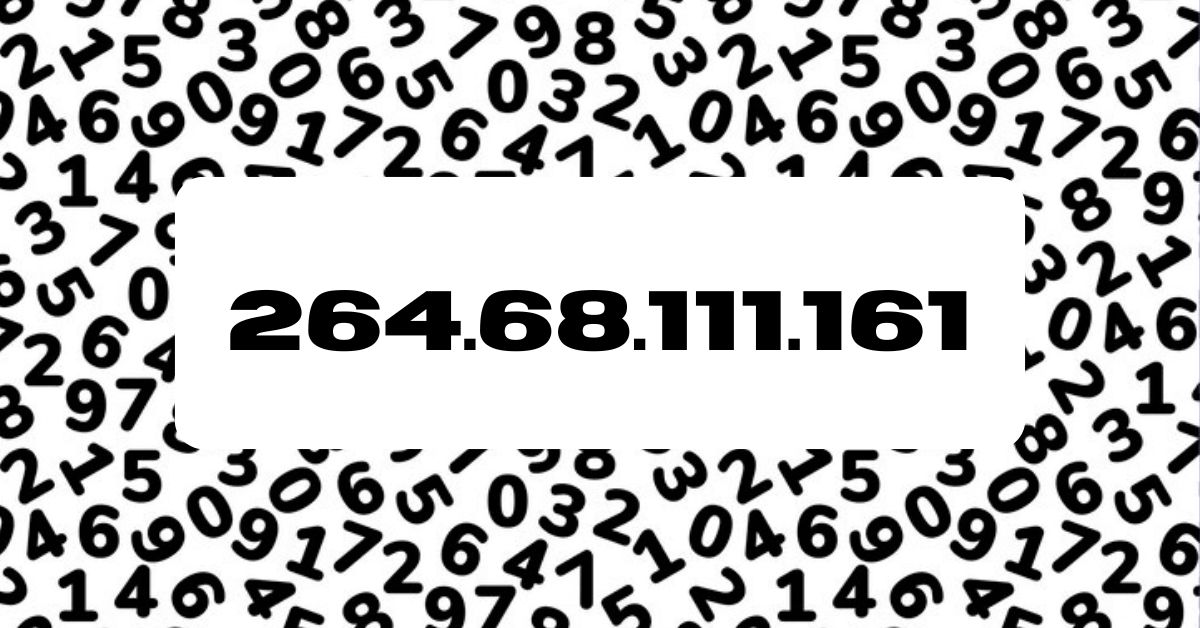Understanding 264.68.111.161 and Its Relevance in the Digital Age
The internet is an essential part of our modern lives, and underlying this vast network of information are unique numerical addresses known as IP addresses. One such example is 264.68.111.161, a specific IP address that serves a crucial role in digital communication. IP addresses, including this are fundamental to the web’s functioning, yet their technical nature often leaves people puzzled. This article explores the significance of IP addresses like 264.68.111.161, breaking down their meaning, usage, and security implications.
What is 264.68.111.161?
The number 264.68.111.161 represents an IP address, which stands for Internet Protocol address. Every device connected to the internet is assigned an IP address to facilitate communication between networks. Think of an IP address as a digital “home address” that ensures data packets get to their intended destination. When you visit a website, stream a video, or send an email, IP addresses such as 264.68.111.161 are at work behind the scenes, directing traffic like a highly efficient postal service.
IP addresses are categorized into two versions globally, IPv4 and IPv6. The address 264.68.111.161 seems aligned with IPv4, a format consisting of four numerical blocks separated by dots. Each block can contain values from 0 to 255, making IPv4 addresses capable of roughly 4.3 billion unique combinations. This is why it follows the structure that appears familiar to those knowledgeable about IP technology.
The Purpose of IP Addresses Like 264.68.111.161
The primary purpose of an address such as 264.68.111.161 is to act as an identifier for devices on a network. Whether it’s a desktop computer, smartphone, router, or server, every internet-enabled device needs an IP address to communicate effectively. There are typically two types of IP addresses in this context:
- Static IP Addresses
Static IPs remain constant and do not change over time. Businesses or hosting servers commonly use them because they require consistent identification, as might be the case with 264.68.111.161 if it belongs to a commercial or technical setup. - Dynamic IP Addresses
Dynamic IPs, on the other hand, are subject to change and are often allocated by Internet Service Providers (ISPs) to individual users.
Since each IP address like they serves as a critical link in this communication chain, even the smallest disruption or misconfiguration can hinder proper connectivity.
Practical Applications of 264.68.111.161
IP addresses such as 264.68.111.161 are much more integral to daily digital experiences than people realize. Without them, accessing websites or connecting with others online would be nearly impossible. Take a look at some practical ways in which IP addresses, including 264.68.111.161, play an essential role:
Website Navigation and Hosting
Whenever you type a website name into a browser, your request is translated into an IP address. Servers hosting websites like ‘example.com’ are linked to specific IP addresses, allowing the system to fetch information and load it on your screen. If it is belongs to a hosting server, it enables seamless website connectivity.
Email and Communication Services
IP addresses like 264.68.111.161 are vital for email servers to function. By identifying the correct digital routes, these addresses ensure that emails send and receive with accuracy, regardless of their origin or destination.
Streaming and Content Delivery
Have you ever streamed a video or enjoyed high-quality content on demand? The back-end communication for these services relies on unique IP addresses such as 264.68.111.161 to deliver content without buffering or interruption. Content Distribution Networks (CDNs) leverage IP technology to distribute files efficiently across different regions.
Is 264.68.111.161 a Public or Private IP?
One common question surrounding IP addresses like 264.68.111.161 involves whether they are public or private. Public IPs are accessible via the internet, enabling global communication and connectivity, while private IPs are limited to internal networks, such as those within a home or corporate setting. Public IPs, which interface with open networks, often face more scrutiny regarding their usage.
Examining 264.68.111.161, it appears to align more closely with the characteristics of a public IP. This means it could be utilized in a context where external devices or systems access associated networks. Depending on its setup, they may represent a server’s unique address or an endpoint critical to global data exchange.
Read Also: Exploring http://www.arlindmorina.info and Its Significance
The Security Implications of 264.68.111.161
With all its utility, IP addresses such as 264.68.111.161 face their share of challenges when it comes to security. Cybersecurity risks, ranging from unauthorized access to malicious traffic, are commonly tied to poorly managed networks.
Unauthorized Access
If an IP like 264.68.111.161 is not adequately secured, hackers may attempt to exploit the address, gaining entry into connected systems. Sensitive data stored on devices tied to this address could then be compromised.
Distributed Denial of Service (DDoS) Attacks
Public IPs can become targets for DDoS attacks, where overwhelming traffic intentionally bombards an IP like 264.68.111.161, rendering its services temporarily unavailable. Businesses relying on such addresses face disruptions, leading to reputational and financial costs.
Identity and Location Tracking
Since public IPs can reveal approximate geographical details, addresses like it could potentially put users or organizations at risk of being tracked without their consent. While exact locations remain hidden, the associated internet service area can sometimes be determined.
To improve security, firewalls, encryption, and IP masking techniques, such as VPNs, can be implemented by entities using IP addresses like 264.68.111.161.
Troubleshooting Issues Related to 264.68.111.161
Occasionally, users may encounter connectivity issues tied to a specific IP such as 264.68.111.161. Whether you’re managing a network or maintaining a web server, there are steps to resolve potential problems:
- Check for Configuration Errors
Ensure the settings associated with 264.68.111.161 are consistent and properly configured in your system. - Monitor Ping and Response Times
Using tools designed to ping an address like this helps you determine whether packets are successfully sent and received or if connectivity issues exist. - Contact Your ISP
Sometimes, a problem with public-facing IP addresses can stem from internet providers. They should be able to confirm the status of an IP like 264.68.111.161.
Future of IP Addressing Beyond
The internet continues to evolve, and IP technologies are no exception. While IPv4 addresses like 264.68.111.161 remain widespread, the shift toward IPv6 solutions signals the next phase of internet architecture. IPv6 offers an expanded address pool with trillions of options, ensuring scalability to meet the growing number of internet-enabled devices.
However, transitional periods always have challenges. Organizations relying on IPv4, including those utilizing it must adapt their infrastructure for compatibility with newer solutions. This shift opens the door to broader innovation while maintaining continuity in existing networks.
Conclusion
IP addresses like 264.68.111.161 are the unseen but indispensable elements powering the internet’s vast ecosystem. From enabling seamless communication to empowering businesses and individuals alike, these numerical identifiers hold the key to connectivity. However, their utility comes with responsibilities, particularly in the realms of privacy, security, and network management. Whether you’re an IT professional, a casual web user, or someone exploring digital technologies, understanding its significance and similar addresses enables you to appreciate the sophistication behind everyday online experiences. With evolving technologies shaping the future of IP addressing, one can only imagine the possibilities that lie ahead.
Read Also: What is fintechzoom.com Crypto Market Cap and Its Significance







